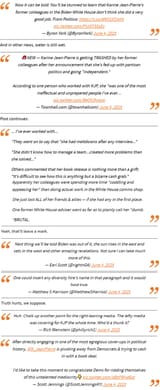Search Results
7/22/2025, 2:59:37 AM
>>511012327
>Where’s the updates and sources for the H1B visa changes please and thank you.
https://www.forbes.com/sites/stuartanderson/
>Where’s the updates and sources for the H1B visa changes please and thank you.
https://www.forbes.com/sites/stuartanderson/
7/11/2025, 11:41:08 PM
>>510125460
The U.S. government posted a surplus in June as tariffs gave an extra bump to a sharp increase in receipts, the Treasury Department said Friday. With government red ink swelling throughout the year, last month saw a surplus of just over $27 billion, following a $316 billion deficit in May. That brought the fiscal year-to-date deficit to $1.34 trillion, up 5% from a year ago. However, with calendar adjustment, the deficit actually edged lower by 1%. There are three months left in the current fiscal year, which ends Sept. 30.
A 13% increase in receipts from the same month a year ago helped bridge the gap, with outlays down 7%. For the year, receipts are up 7% while spending has risen 6%. The government last posted a June surplus in 2017, during President Donald Trump’s first term. Increasing tariff collections are helping shore up the government finances. Customs duties totaled about $27 billion for the month, up from $23 billion in May and 301% higher than June 2024. On an annual basis, tariff collections have totaled $113 billion, or 86% more than a year ago.
Net interest on the $36 trillion national debt totaled $84 billion in June, down slightly from May but still higher than any other category with the exception of Social Security. For the year, net interest, what Treasury pays on the debt it issues minus what it earns on investments, is at $749 billion. Total interest payments are projected at $1.2 trillion for the full fiscal year. Trump has been pushing the Federal Reserve to cut short-term rates to help with the financing burden of servicing federal debt. But markets don’t expect the central bank to ease again until September, and Fed Chair Jerome Powell has said he remains leery of the potential impact that tariffs might have on inflation.
The U.S. government posted a surplus in June as tariffs gave an extra bump to a sharp increase in receipts, the Treasury Department said Friday. With government red ink swelling throughout the year, last month saw a surplus of just over $27 billion, following a $316 billion deficit in May. That brought the fiscal year-to-date deficit to $1.34 trillion, up 5% from a year ago. However, with calendar adjustment, the deficit actually edged lower by 1%. There are three months left in the current fiscal year, which ends Sept. 30.
A 13% increase in receipts from the same month a year ago helped bridge the gap, with outlays down 7%. For the year, receipts are up 7% while spending has risen 6%. The government last posted a June surplus in 2017, during President Donald Trump’s first term. Increasing tariff collections are helping shore up the government finances. Customs duties totaled about $27 billion for the month, up from $23 billion in May and 301% higher than June 2024. On an annual basis, tariff collections have totaled $113 billion, or 86% more than a year ago.
Net interest on the $36 trillion national debt totaled $84 billion in June, down slightly from May but still higher than any other category with the exception of Social Security. For the year, net interest, what Treasury pays on the debt it issues minus what it earns on investments, is at $749 billion. Total interest payments are projected at $1.2 trillion for the full fiscal year. Trump has been pushing the Federal Reserve to cut short-term rates to help with the financing burden of servicing federal debt. But markets don’t expect the central bank to ease again until September, and Fed Chair Jerome Powell has said he remains leery of the potential impact that tariffs might have on inflation.
7/4/2025, 6:00:00 AM
Page 1
